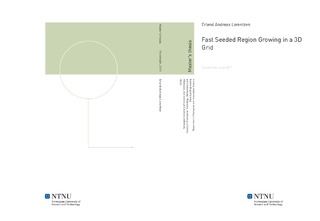Fast Seeded Region Growing in a 3D Grid
Master thesis
Permanent lenke
http://hdl.handle.net/11250/252779Utgivelsesdato
2011Metadata
Vis full innførselSamlinger
Sammendrag
The purpose of this thesis was to examine ways to adapt common 2D segmentation techniques to work with 3D grids. The focus of the thesis became how to automate and improve the performance of region growing in 3D grids. After examining relevant literature and developing a tool to run experiments, a simple automatic region grower for 3D grids was developed. Quantitative performance measures and qualitative analysis of the segmentation results were performed. This algorithm was then used as a baseline for comparison when developing a more advanced region grower for 3D grids based on the seeded region grower (SRG) for 2D grids. This new algorithm was then modified to improve its speed and later extended to allow fully automatic operation by automating the placement of starting seeds. It was found that for the algorithms that were extended to a 3D grid, the main challenge was the resources needed by these algorithms when operating on high resolution grids. It was found that even though there have been steady and rapid improvements in consumer hardware since the original region growing algorithms were used on 2D grids, the very large amounts of data resulting from an extension from surface grids to volume grids requires that special attention is paid to handling resources effectively. It was further revealed that what was considered the best data structures and algorithms for the SRG algorithm when it was first introduced, is not necessarily the best choice on todays computing hardware. Also, the conclusion is drawn that with regards to performance, it is now possible to segment volumes approximately as fast as surfaces were segmented in the early 1990s.
